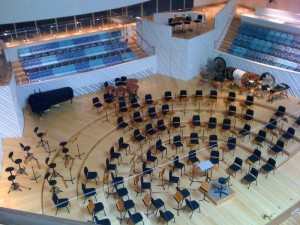
New World’s New House Already Feels Like a Home
The first thing I thought when I walked into the new concert hall at the soon-to-open New World Symphony building was: This feels like a home.
Taking a tour of the Frank Gehry-designed structure in Miami Beach earlier this week, I walked into the main hall expecting, vaguely, something imposing and palatial. But while the hall is undeniably impressive, what struck me most was the intimacy of the place, with its tall rows of seats decked out in white-patterned turquoise and cornflower blue leaning in over the stage down below.
You get the sense that this is a place where listeners and performers can be comfortable, where old and new music alike can be aired to welcoming ears. There’s something about the natural light, the blond wood and the white walls that encourages a kind of Florida-room feel to the hall that’s most appealing.
And it’s a lovely structure overall, full of nooks where music can happen. The building’s SunTrust Pavilion, which will be used for chamber music performances, has windows that allow outside views of the players inside, much like the Miami City Ballet rehearsal studio lured passersby to watch dancers at work. There is a rehearsal room in the middle of one floor that also is surrounded by windows, which adds to the general air of openness throughout.
Outside, in the park that adjoins the building, speakers line two large green handle-like structures, delivering sound to audiences seated outside who can listen to the music and watch video of the performances on the huge open wall near the front entrance. I like this park idea particularly, because this is the kind of effort that encourages the idea that it’s normal and wonderful for a city to have a home for art music right in the middle of street, right next to a green space, rather than being set off in a remote area away from the action.
The New World Symphony has always been proud of its commitment to technology, and here, too, the new structure makes advances. Music can be recorded everywhere in the building, it seems, and that will comprise a marvelous resource for training. I’m told that master classes will be recorded and archived and made available on the Web for anyone to see, and I’m hoping there will be some sort of indexing system that allows viewers to look up a specific piece that was discussed in the classes and then check out the insight.
One of the most crucial things for an orchestra is for it to have its own rehearsal space, and not be restricted to playing together only when they can get the hall they share with any number of other presenters and presentations. It makes a difference, because with that, players can not only feel that they can fully engage in the work at hand, but that the community at large accepts them and welcomes them as they work.
That’s one definition of feeling at home, anyway, and the concert hall at the Gehry building reinforces that. The structure strikes me already as a success, and as a cultural draw it is likely to be a model for other cities hoping to bring a similar sense of engagement with the arts to their citizens.
Recent Content
-
Artsarticle ·
-
Artsarticle ·
-
Artsarticle ·

